Counselling in a Community Service Setting: CBT and Patient Outcomes
VerifiedAdded on 2022/10/17
|8
|2281
|52
Essay
AI Summary
This essay explores the application of Cognitive Behavioral Therapy (CBT) within a community service setting. It delves into the principles of CBT, highlighting its effectiveness in addressing issues such as post-traumatic stress, anxiety, depression, and addiction. The essay outlines the processes involved in CBT, including identifying and modifying destructive behaviors to foster positive mental and behavioral changes. It reflects on the author's experience as a counsellor, emphasizing the importance of client respect and the benefits of both individual and group therapy sessions. Furthermore, the essay underscores CBT's problem-specific, time-efficient nature, and its role in empowering clients to take control of their recovery. It also provides insights into the ethical considerations and the impact of counselling on both clients and practitioners within the social work context, drawing on various research studies to support its claims.
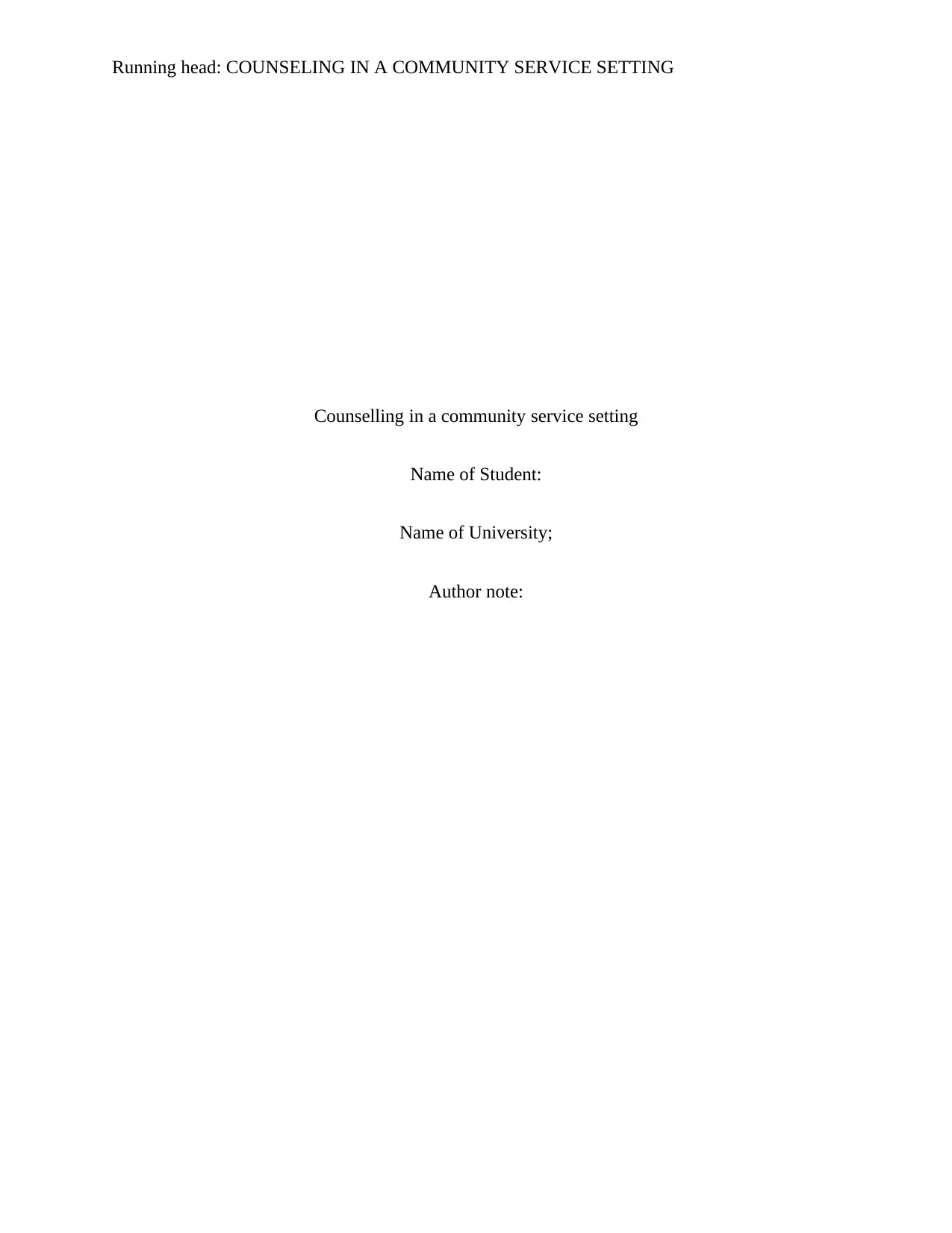
Running head: COUNSELING IN A COMMUNITY SERVICE SETTING
Counselling in a community service setting
Name of Student:
Name of University;
Author note:
Counselling in a community service setting
Name of Student:
Name of University;
Author note:
Paraphrase This Document
Need a fresh take? Get an instant paraphrase of this document with our AI Paraphraser
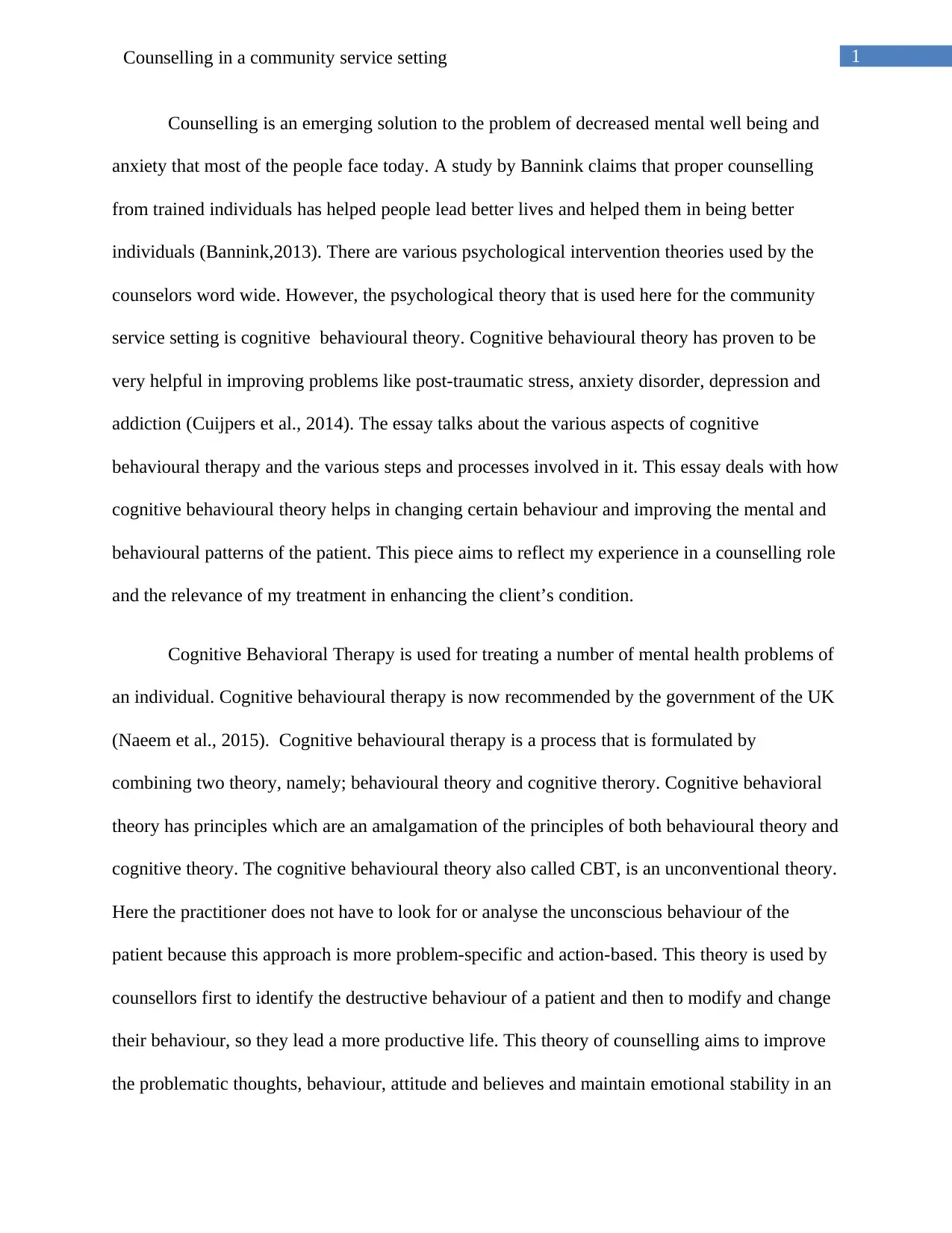
1Counselling in a community service setting
Counselling is an emerging solution to the problem of decreased mental well being and
anxiety that most of the people face today. A study by Bannink claims that proper counselling
from trained individuals has helped people lead better lives and helped them in being better
individuals (Bannink,2013). There are various psychological intervention theories used by the
counselors word wide. However, the psychological theory that is used here for the community
service setting is cognitive behavioural theory. Cognitive behavioural theory has proven to be
very helpful in improving problems like post-traumatic stress, anxiety disorder, depression and
addiction (Cuijpers et al., 2014). The essay talks about the various aspects of cognitive
behavioural therapy and the various steps and processes involved in it. This essay deals with how
cognitive behavioural theory helps in changing certain behaviour and improving the mental and
behavioural patterns of the patient. This piece aims to reflect my experience in a counselling role
and the relevance of my treatment in enhancing the client’s condition.
Cognitive Behavioral Therapy is used for treating a number of mental health problems of
an individual. Cognitive behavioural therapy is now recommended by the government of the UK
(Naeem et al., 2015). Cognitive behavioural therapy is a process that is formulated by
combining two theory, namely; behavioural theory and cognitive therory. Cognitive behavioral
theory has principles which are an amalgamation of the principles of both behavioural theory and
cognitive theory. The cognitive behavioural theory also called CBT, is an unconventional theory.
Here the practitioner does not have to look for or analyse the unconscious behaviour of the
patient because this approach is more problem-specific and action-based. This theory is used by
counsellors first to identify the destructive behaviour of a patient and then to modify and change
their behaviour, so they lead a more productive life. This theory of counselling aims to improve
the problematic thoughts, behaviour, attitude and believes and maintain emotional stability in an
Counselling is an emerging solution to the problem of decreased mental well being and
anxiety that most of the people face today. A study by Bannink claims that proper counselling
from trained individuals has helped people lead better lives and helped them in being better
individuals (Bannink,2013). There are various psychological intervention theories used by the
counselors word wide. However, the psychological theory that is used here for the community
service setting is cognitive behavioural theory. Cognitive behavioural theory has proven to be
very helpful in improving problems like post-traumatic stress, anxiety disorder, depression and
addiction (Cuijpers et al., 2014). The essay talks about the various aspects of cognitive
behavioural therapy and the various steps and processes involved in it. This essay deals with how
cognitive behavioural theory helps in changing certain behaviour and improving the mental and
behavioural patterns of the patient. This piece aims to reflect my experience in a counselling role
and the relevance of my treatment in enhancing the client’s condition.
Cognitive Behavioral Therapy is used for treating a number of mental health problems of
an individual. Cognitive behavioural therapy is now recommended by the government of the UK
(Naeem et al., 2015). Cognitive behavioural therapy is a process that is formulated by
combining two theory, namely; behavioural theory and cognitive therory. Cognitive behavioral
theory has principles which are an amalgamation of the principles of both behavioural theory and
cognitive theory. The cognitive behavioural theory also called CBT, is an unconventional theory.
Here the practitioner does not have to look for or analyse the unconscious behaviour of the
patient because this approach is more problem-specific and action-based. This theory is used by
counsellors first to identify the destructive behaviour of a patient and then to modify and change
their behaviour, so they lead a more productive life. This theory of counselling aims to improve
the problematic thoughts, behaviour, attitude and believes and maintain emotional stability in an
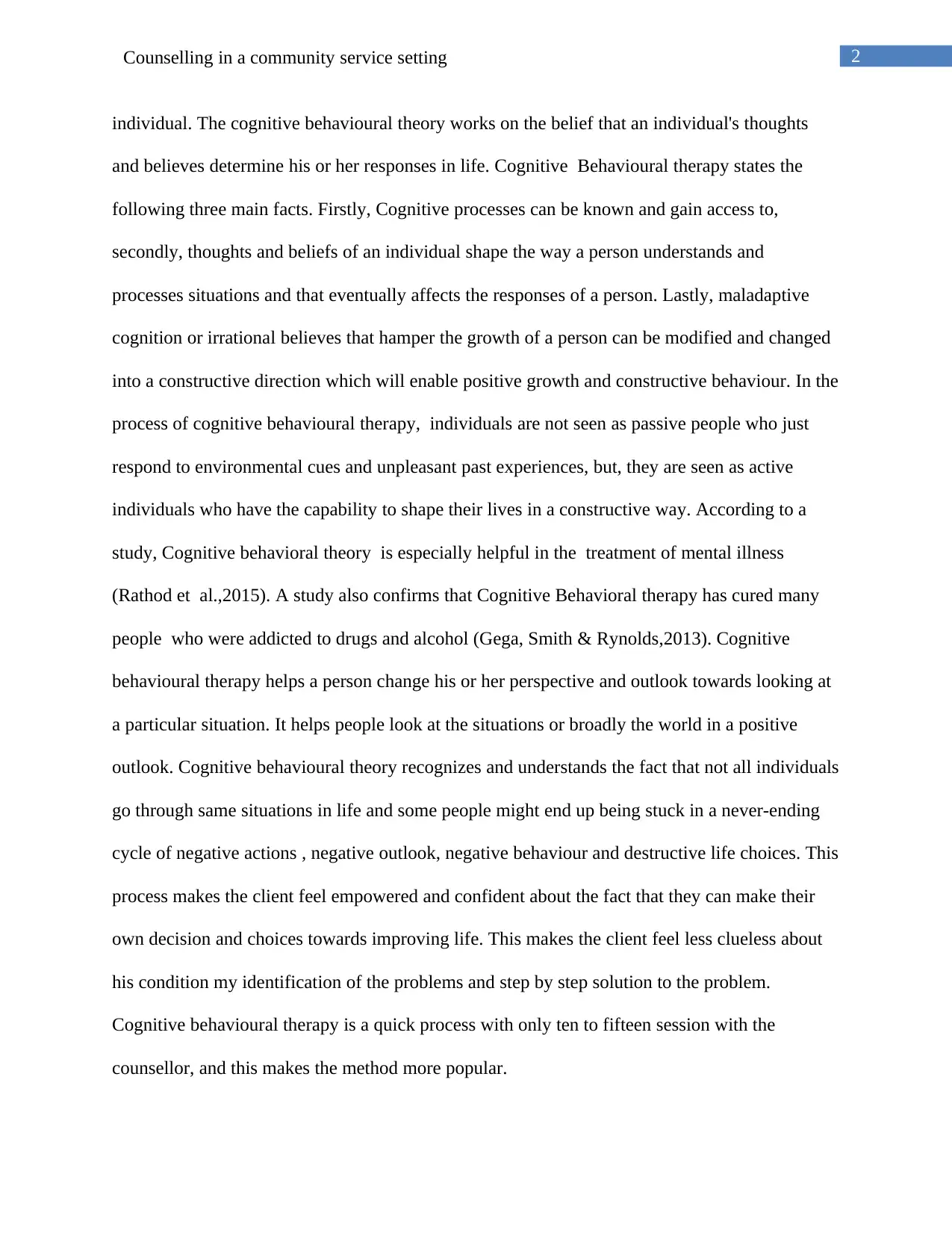
2Counselling in a community service setting
individual. The cognitive behavioural theory works on the belief that an individual's thoughts
and believes determine his or her responses in life. Cognitive Behavioural therapy states the
following three main facts. Firstly, Cognitive processes can be known and gain access to,
secondly, thoughts and beliefs of an individual shape the way a person understands and
processes situations and that eventually affects the responses of a person. Lastly, maladaptive
cognition or irrational believes that hamper the growth of a person can be modified and changed
into a constructive direction which will enable positive growth and constructive behaviour. In the
process of cognitive behavioural therapy, individuals are not seen as passive people who just
respond to environmental cues and unpleasant past experiences, but, they are seen as active
individuals who have the capability to shape their lives in a constructive way. According to a
study, Cognitive behavioral theory is especially helpful in the treatment of mental illness
(Rathod et al.,2015). A study also confirms that Cognitive Behavioral therapy has cured many
people who were addicted to drugs and alcohol (Gega, Smith & Rynolds,2013). Cognitive
behavioural therapy helps a person change his or her perspective and outlook towards looking at
a particular situation. It helps people look at the situations or broadly the world in a positive
outlook. Cognitive behavioural theory recognizes and understands the fact that not all individuals
go through same situations in life and some people might end up being stuck in a never-ending
cycle of negative actions , negative outlook, negative behaviour and destructive life choices. This
process makes the client feel empowered and confident about the fact that they can make their
own decision and choices towards improving life. This makes the client feel less clueless about
his condition my identification of the problems and step by step solution to the problem.
Cognitive behavioural therapy is a quick process with only ten to fifteen session with the
counsellor, and this makes the method more popular.
individual. The cognitive behavioural theory works on the belief that an individual's thoughts
and believes determine his or her responses in life. Cognitive Behavioural therapy states the
following three main facts. Firstly, Cognitive processes can be known and gain access to,
secondly, thoughts and beliefs of an individual shape the way a person understands and
processes situations and that eventually affects the responses of a person. Lastly, maladaptive
cognition or irrational believes that hamper the growth of a person can be modified and changed
into a constructive direction which will enable positive growth and constructive behaviour. In the
process of cognitive behavioural therapy, individuals are not seen as passive people who just
respond to environmental cues and unpleasant past experiences, but, they are seen as active
individuals who have the capability to shape their lives in a constructive way. According to a
study, Cognitive behavioral theory is especially helpful in the treatment of mental illness
(Rathod et al.,2015). A study also confirms that Cognitive Behavioral therapy has cured many
people who were addicted to drugs and alcohol (Gega, Smith & Rynolds,2013). Cognitive
behavioural therapy helps a person change his or her perspective and outlook towards looking at
a particular situation. It helps people look at the situations or broadly the world in a positive
outlook. Cognitive behavioural theory recognizes and understands the fact that not all individuals
go through same situations in life and some people might end up being stuck in a never-ending
cycle of negative actions , negative outlook, negative behaviour and destructive life choices. This
process makes the client feel empowered and confident about the fact that they can make their
own decision and choices towards improving life. This makes the client feel less clueless about
his condition my identification of the problems and step by step solution to the problem.
Cognitive behavioural therapy is a quick process with only ten to fifteen session with the
counsellor, and this makes the method more popular.
⊘ This is a preview!⊘
Do you want full access?
Subscribe today to unlock all pages.

Trusted by 1+ million students worldwide
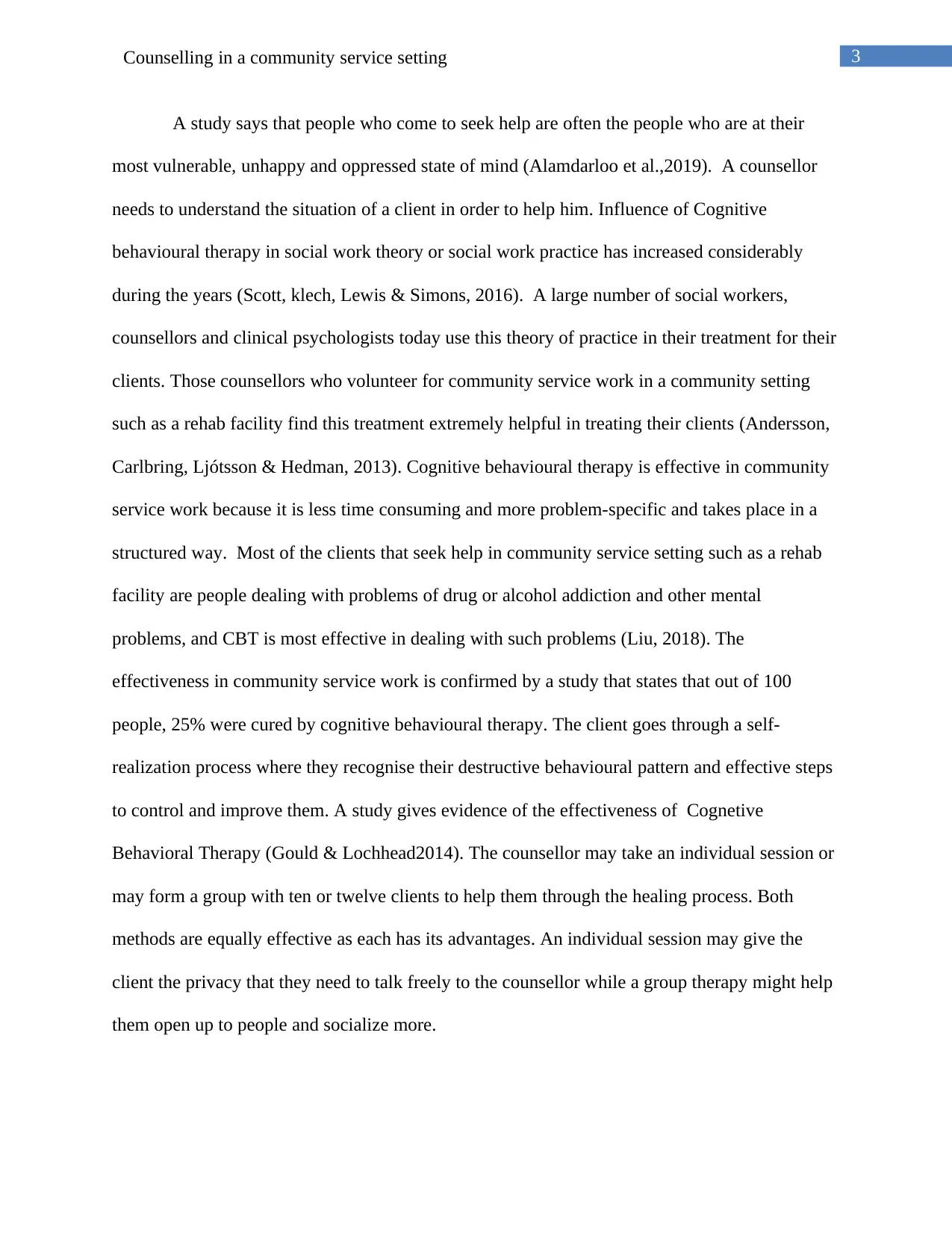
3Counselling in a community service setting
A study says that people who come to seek help are often the people who are at their
most vulnerable, unhappy and oppressed state of mind (Alamdarloo et al.,2019). A counsellor
needs to understand the situation of a client in order to help him. Influence of Cognitive
behavioural therapy in social work theory or social work practice has increased considerably
during the years (Scott, klech, Lewis & Simons, 2016). A large number of social workers,
counsellors and clinical psychologists today use this theory of practice in their treatment for their
clients. Those counsellors who volunteer for community service work in a community setting
such as a rehab facility find this treatment extremely helpful in treating their clients (Andersson,
Carlbring, Ljótsson & Hedman, 2013). Cognitive behavioural therapy is effective in community
service work because it is less time consuming and more problem-specific and takes place in a
structured way. Most of the clients that seek help in community service setting such as a rehab
facility are people dealing with problems of drug or alcohol addiction and other mental
problems, and CBT is most effective in dealing with such problems (Liu, 2018). The
effectiveness in community service work is confirmed by a study that states that out of 100
people, 25% were cured by cognitive behavioural therapy. The client goes through a self-
realization process where they recognise their destructive behavioural pattern and effective steps
to control and improve them. A study gives evidence of the effectiveness of Cognetive
Behavioral Therapy (Gould & Lochhead2014). The counsellor may take an individual session or
may form a group with ten or twelve clients to help them through the healing process. Both
methods are equally effective as each has its advantages. An individual session may give the
client the privacy that they need to talk freely to the counsellor while a group therapy might help
them open up to people and socialize more.
A study says that people who come to seek help are often the people who are at their
most vulnerable, unhappy and oppressed state of mind (Alamdarloo et al.,2019). A counsellor
needs to understand the situation of a client in order to help him. Influence of Cognitive
behavioural therapy in social work theory or social work practice has increased considerably
during the years (Scott, klech, Lewis & Simons, 2016). A large number of social workers,
counsellors and clinical psychologists today use this theory of practice in their treatment for their
clients. Those counsellors who volunteer for community service work in a community setting
such as a rehab facility find this treatment extremely helpful in treating their clients (Andersson,
Carlbring, Ljótsson & Hedman, 2013). Cognitive behavioural therapy is effective in community
service work because it is less time consuming and more problem-specific and takes place in a
structured way. Most of the clients that seek help in community service setting such as a rehab
facility are people dealing with problems of drug or alcohol addiction and other mental
problems, and CBT is most effective in dealing with such problems (Liu, 2018). The
effectiveness in community service work is confirmed by a study that states that out of 100
people, 25% were cured by cognitive behavioural therapy. The client goes through a self-
realization process where they recognise their destructive behavioural pattern and effective steps
to control and improve them. A study gives evidence of the effectiveness of Cognetive
Behavioral Therapy (Gould & Lochhead2014). The counsellor may take an individual session or
may form a group with ten or twelve clients to help them through the healing process. Both
methods are equally effective as each has its advantages. An individual session may give the
client the privacy that they need to talk freely to the counsellor while a group therapy might help
them open up to people and socialize more.
Paraphrase This Document
Need a fresh take? Get an instant paraphrase of this document with our AI Paraphraser
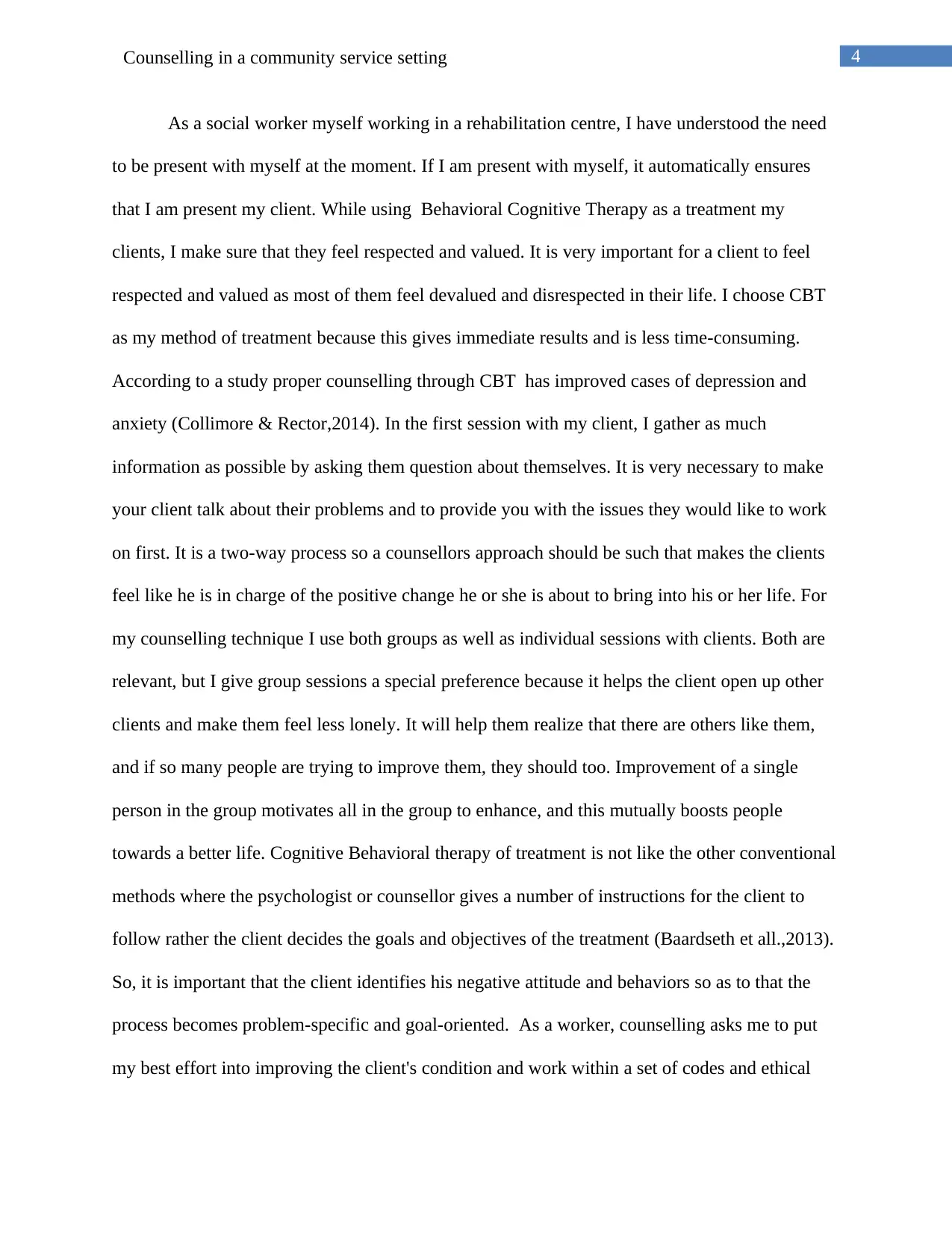
4Counselling in a community service setting
As a social worker myself working in a rehabilitation centre, I have understood the need
to be present with myself at the moment. If I am present with myself, it automatically ensures
that I am present my client. While using Behavioral Cognitive Therapy as a treatment my
clients, I make sure that they feel respected and valued. It is very important for a client to feel
respected and valued as most of them feel devalued and disrespected in their life. I choose CBT
as my method of treatment because this gives immediate results and is less time-consuming.
According to a study proper counselling through CBT has improved cases of depression and
anxiety (Collimore & Rector,2014). In the first session with my client, I gather as much
information as possible by asking them question about themselves. It is very necessary to make
your client talk about their problems and to provide you with the issues they would like to work
on first. It is a two-way process so a counsellors approach should be such that makes the clients
feel like he is in charge of the positive change he or she is about to bring into his or her life. For
my counselling technique I use both groups as well as individual sessions with clients. Both are
relevant, but I give group sessions a special preference because it helps the client open up other
clients and make them feel less lonely. It will help them realize that there are others like them,
and if so many people are trying to improve them, they should too. Improvement of a single
person in the group motivates all in the group to enhance, and this mutually boosts people
towards a better life. Cognitive Behavioral therapy of treatment is not like the other conventional
methods where the psychologist or counsellor gives a number of instructions for the client to
follow rather the client decides the goals and objectives of the treatment (Baardseth et all.,2013).
So, it is important that the client identifies his negative attitude and behaviors so as to that the
process becomes problem-specific and goal-oriented. As a worker, counselling asks me to put
my best effort into improving the client's condition and work within a set of codes and ethical
As a social worker myself working in a rehabilitation centre, I have understood the need
to be present with myself at the moment. If I am present with myself, it automatically ensures
that I am present my client. While using Behavioral Cognitive Therapy as a treatment my
clients, I make sure that they feel respected and valued. It is very important for a client to feel
respected and valued as most of them feel devalued and disrespected in their life. I choose CBT
as my method of treatment because this gives immediate results and is less time-consuming.
According to a study proper counselling through CBT has improved cases of depression and
anxiety (Collimore & Rector,2014). In the first session with my client, I gather as much
information as possible by asking them question about themselves. It is very necessary to make
your client talk about their problems and to provide you with the issues they would like to work
on first. It is a two-way process so a counsellors approach should be such that makes the clients
feel like he is in charge of the positive change he or she is about to bring into his or her life. For
my counselling technique I use both groups as well as individual sessions with clients. Both are
relevant, but I give group sessions a special preference because it helps the client open up other
clients and make them feel less lonely. It will help them realize that there are others like them,
and if so many people are trying to improve them, they should too. Improvement of a single
person in the group motivates all in the group to enhance, and this mutually boosts people
towards a better life. Cognitive Behavioral therapy of treatment is not like the other conventional
methods where the psychologist or counsellor gives a number of instructions for the client to
follow rather the client decides the goals and objectives of the treatment (Baardseth et all.,2013).
So, it is important that the client identifies his negative attitude and behaviors so as to that the
process becomes problem-specific and goal-oriented. As a worker, counselling asks me to put
my best effort into improving the client's condition and work within a set of codes and ethical
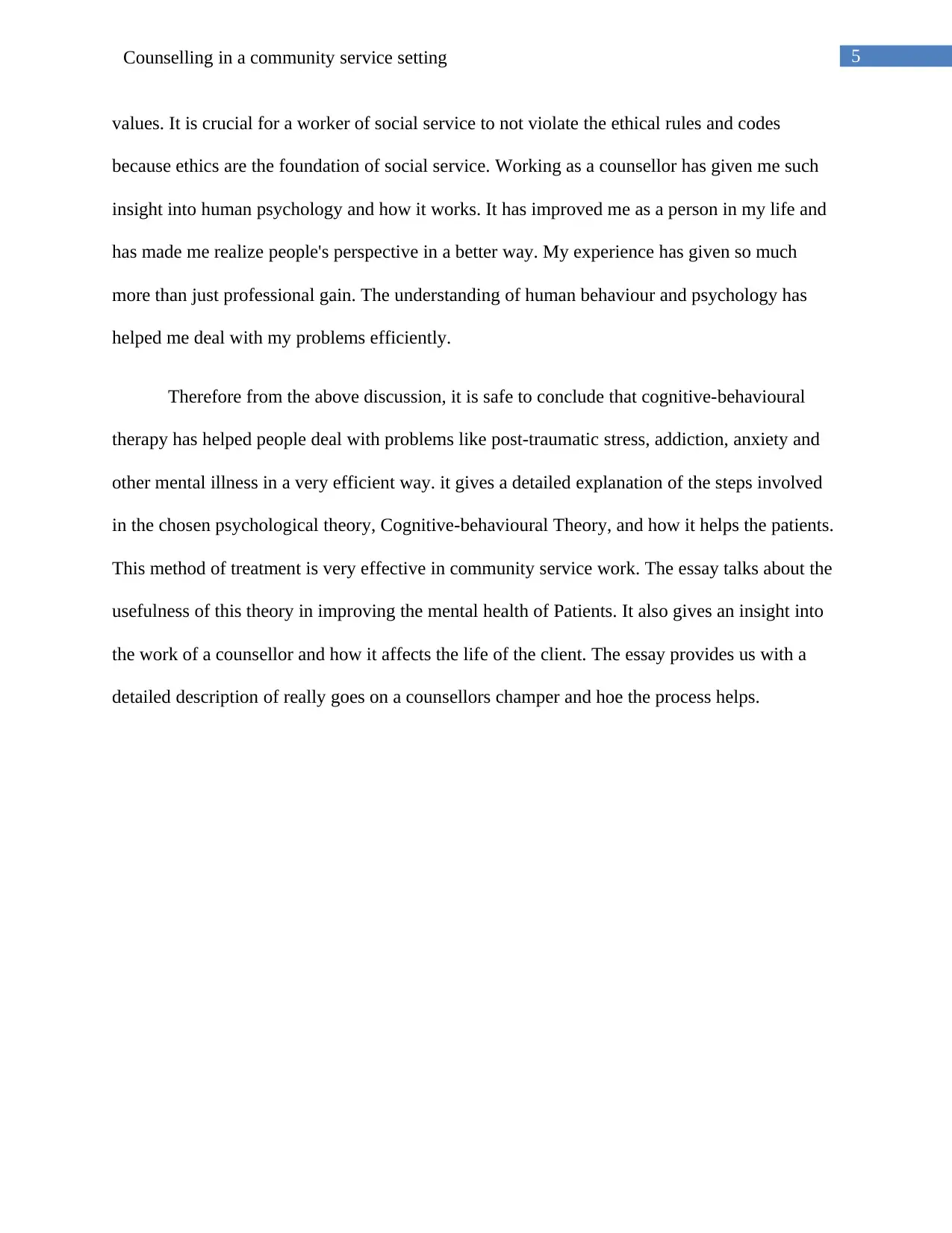
5Counselling in a community service setting
values. It is crucial for a worker of social service to not violate the ethical rules and codes
because ethics are the foundation of social service. Working as a counsellor has given me such
insight into human psychology and how it works. It has improved me as a person in my life and
has made me realize people's perspective in a better way. My experience has given so much
more than just professional gain. The understanding of human behaviour and psychology has
helped me deal with my problems efficiently.
Therefore from the above discussion, it is safe to conclude that cognitive-behavioural
therapy has helped people deal with problems like post-traumatic stress, addiction, anxiety and
other mental illness in a very efficient way. it gives a detailed explanation of the steps involved
in the chosen psychological theory, Cognitive-behavioural Theory, and how it helps the patients.
This method of treatment is very effective in community service work. The essay talks about the
usefulness of this theory in improving the mental health of Patients. It also gives an insight into
the work of a counsellor and how it affects the life of the client. The essay provides us with a
detailed description of really goes on a counsellors champer and hoe the process helps.
values. It is crucial for a worker of social service to not violate the ethical rules and codes
because ethics are the foundation of social service. Working as a counsellor has given me such
insight into human psychology and how it works. It has improved me as a person in my life and
has made me realize people's perspective in a better way. My experience has given so much
more than just professional gain. The understanding of human behaviour and psychology has
helped me deal with my problems efficiently.
Therefore from the above discussion, it is safe to conclude that cognitive-behavioural
therapy has helped people deal with problems like post-traumatic stress, addiction, anxiety and
other mental illness in a very efficient way. it gives a detailed explanation of the steps involved
in the chosen psychological theory, Cognitive-behavioural Theory, and how it helps the patients.
This method of treatment is very effective in community service work. The essay talks about the
usefulness of this theory in improving the mental health of Patients. It also gives an insight into
the work of a counsellor and how it affects the life of the client. The essay provides us with a
detailed description of really goes on a counsellors champer and hoe the process helps.
⊘ This is a preview!⊘
Do you want full access?
Subscribe today to unlock all pages.

Trusted by 1+ million students worldwide
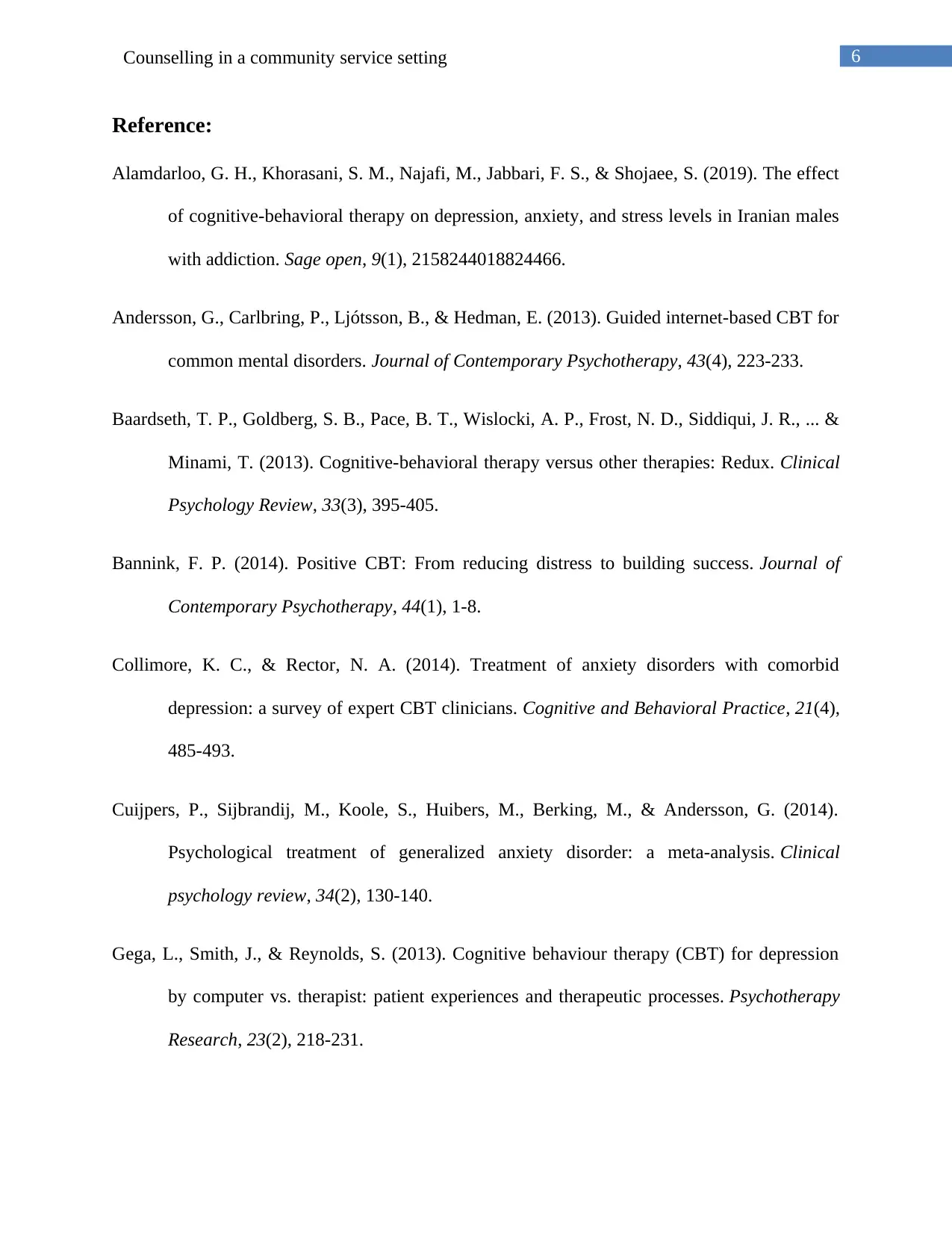
6Counselling in a community service setting
Reference:
Alamdarloo, G. H., Khorasani, S. M., Najafi, M., Jabbari, F. S., & Shojaee, S. (2019). The effect
of cognitive-behavioral therapy on depression, anxiety, and stress levels in Iranian males
with addiction. Sage open, 9(1), 2158244018824466.
Andersson, G., Carlbring, P., Ljótsson, B., & Hedman, E. (2013). Guided internet-based CBT for
common mental disorders. Journal of Contemporary Psychotherapy, 43(4), 223-233.
Baardseth, T. P., Goldberg, S. B., Pace, B. T., Wislocki, A. P., Frost, N. D., Siddiqui, J. R., ... &
Minami, T. (2013). Cognitive-behavioral therapy versus other therapies: Redux. Clinical
Psychology Review, 33(3), 395-405.
Bannink, F. P. (2014). Positive CBT: From reducing distress to building success. Journal of
Contemporary Psychotherapy, 44(1), 1-8.
Collimore, K. C., & Rector, N. A. (2014). Treatment of anxiety disorders with comorbid
depression: a survey of expert CBT clinicians. Cognitive and Behavioral Practice, 21(4),
485-493.
Cuijpers, P., Sijbrandij, M., Koole, S., Huibers, M., Berking, M., & Andersson, G. (2014).
Psychological treatment of generalized anxiety disorder: a meta-analysis. Clinical
psychology review, 34(2), 130-140.
Gega, L., Smith, J., & Reynolds, S. (2013). Cognitive behaviour therapy (CBT) for depression
by computer vs. therapist: patient experiences and therapeutic processes. Psychotherapy
Research, 23(2), 218-231.
Reference:
Alamdarloo, G. H., Khorasani, S. M., Najafi, M., Jabbari, F. S., & Shojaee, S. (2019). The effect
of cognitive-behavioral therapy on depression, anxiety, and stress levels in Iranian males
with addiction. Sage open, 9(1), 2158244018824466.
Andersson, G., Carlbring, P., Ljótsson, B., & Hedman, E. (2013). Guided internet-based CBT for
common mental disorders. Journal of Contemporary Psychotherapy, 43(4), 223-233.
Baardseth, T. P., Goldberg, S. B., Pace, B. T., Wislocki, A. P., Frost, N. D., Siddiqui, J. R., ... &
Minami, T. (2013). Cognitive-behavioral therapy versus other therapies: Redux. Clinical
Psychology Review, 33(3), 395-405.
Bannink, F. P. (2014). Positive CBT: From reducing distress to building success. Journal of
Contemporary Psychotherapy, 44(1), 1-8.
Collimore, K. C., & Rector, N. A. (2014). Treatment of anxiety disorders with comorbid
depression: a survey of expert CBT clinicians. Cognitive and Behavioral Practice, 21(4),
485-493.
Cuijpers, P., Sijbrandij, M., Koole, S., Huibers, M., Berking, M., & Andersson, G. (2014).
Psychological treatment of generalized anxiety disorder: a meta-analysis. Clinical
psychology review, 34(2), 130-140.
Gega, L., Smith, J., & Reynolds, S. (2013). Cognitive behaviour therapy (CBT) for depression
by computer vs. therapist: patient experiences and therapeutic processes. Psychotherapy
Research, 23(2), 218-231.
Paraphrase This Document
Need a fresh take? Get an instant paraphrase of this document with our AI Paraphraser
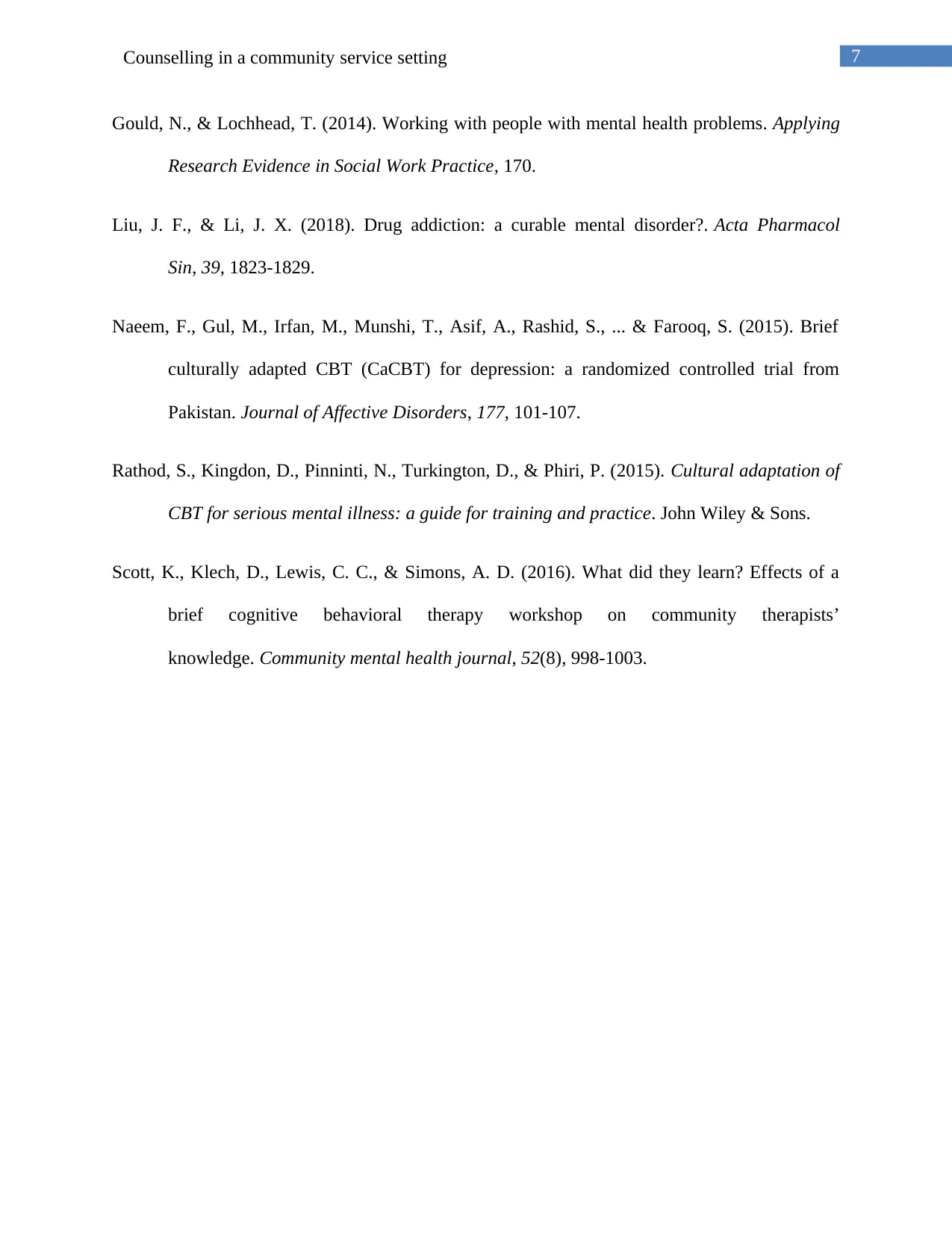
7Counselling in a community service setting
Gould, N., & Lochhead, T. (2014). Working with people with mental health problems. Applying
Research Evidence in Social Work Practice, 170.
Liu, J. F., & Li, J. X. (2018). Drug addiction: a curable mental disorder?. Acta Pharmacol
Sin, 39, 1823-1829.
Naeem, F., Gul, M., Irfan, M., Munshi, T., Asif, A., Rashid, S., ... & Farooq, S. (2015). Brief
culturally adapted CBT (CaCBT) for depression: a randomized controlled trial from
Pakistan. Journal of Affective Disorders, 177, 101-107.
Rathod, S., Kingdon, D., Pinninti, N., Turkington, D., & Phiri, P. (2015). Cultural adaptation of
CBT for serious mental illness: a guide for training and practice. John Wiley & Sons.
Scott, K., Klech, D., Lewis, C. C., & Simons, A. D. (2016). What did they learn? Effects of a
brief cognitive behavioral therapy workshop on community therapists’
knowledge. Community mental health journal, 52(8), 998-1003.
Gould, N., & Lochhead, T. (2014). Working with people with mental health problems. Applying
Research Evidence in Social Work Practice, 170.
Liu, J. F., & Li, J. X. (2018). Drug addiction: a curable mental disorder?. Acta Pharmacol
Sin, 39, 1823-1829.
Naeem, F., Gul, M., Irfan, M., Munshi, T., Asif, A., Rashid, S., ... & Farooq, S. (2015). Brief
culturally adapted CBT (CaCBT) for depression: a randomized controlled trial from
Pakistan. Journal of Affective Disorders, 177, 101-107.
Rathod, S., Kingdon, D., Pinninti, N., Turkington, D., & Phiri, P. (2015). Cultural adaptation of
CBT for serious mental illness: a guide for training and practice. John Wiley & Sons.
Scott, K., Klech, D., Lewis, C. C., & Simons, A. D. (2016). What did they learn? Effects of a
brief cognitive behavioral therapy workshop on community therapists’
knowledge. Community mental health journal, 52(8), 998-1003.
1 out of 8
Related Documents
Your All-in-One AI-Powered Toolkit for Academic Success.
+13062052269
info@desklib.com
Available 24*7 on WhatsApp / Email
![[object Object]](/_next/static/media/star-bottom.7253800d.svg)
Unlock your academic potential
Copyright © 2020–2025 A2Z Services. All Rights Reserved. Developed and managed by ZUCOL.



